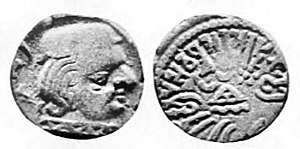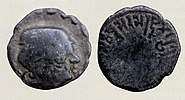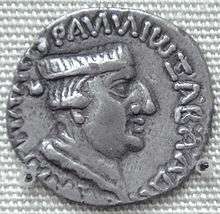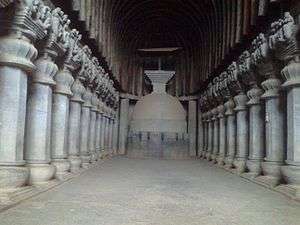Visvasena
Viśvasena (Middle Brahmi: ![]()
| Visvasena | |
|---|---|
  Rājño Mahākshatrapasa Bhartṛidāmnaḥ putrasa Rājñaḥ Kshatrapasa Viçvasenasa "Of the Rajah and Satrap Visnasena, brother of the Rajah and Great Satrap Bhartrdaman".[1] | |
| Western Satraps | |
| Reign | 293-304 CE |
| Predecessor | Bhartrdaman |
| Successor | Rudrasimha II |
| Father | Rudrasena II |
Western Satrap territory extended from the west coast of India to Vidisha/ Sanchi and Eran, from the time of Rudrasena II (256–278) well into the 4th century.[2] Marital alliances with the Ikshvaku of southern India are mentioned in inscriptions at Nagarjunakonda (3rd century CE).[3][4]
A coin of Visvasena was found in excavations at the Ajanta Caves, in the burnt-brick monastery facing the caves on the right bank of the river Waghora.[6]
His successor was Rudrasimha II.[5]
 A coin of Visvasena, found in excavations at Ajanta Caves.
A coin of Visvasena, found in excavations at Ajanta Caves.
References
- Bhagvanlal, Pandit (1834). Journal of the Royal Asiatic Society of Great Britain & Ireland. Cambridge University Press for the Royal Asiatic Society. p. 659.
- Buddhist Landscapes in Central India: Sanchi Hill and Archaeologies of Religious and Social Change, c. Third Century BC to Fifth Century AD, Julia Shaw, Routledge, 2016 p58-59
- "Another queen of Virapurusha was Rudradhara-bhattarika. According to D.C. Sircar she might have been related to Rudrasena II (c. a.d. 254-74) the Saka ruler of Western India" in Rao, P. Raghunadha (1993). Ancient and medieval history of Andhra Pradesh. Sterling Publishers. p. 23. ISBN 9788120714953.
- (India), Madhya Pradesh (1982). Madhya Pradesh District Gazetteers: Ujjain. Government Central Press. p. 26.
- The Cambridge Shorter History of India. CUP Archive. p. 84.
- Mitra, Debala (2004). Ajanta. Archaeological Survey of India. pp. 94-95.
Sources
- K. Krishna Murthy (1977). Nāgārjunakoṇḍā: A Cultural Study. Concept. OCLC 4541213.CS1 maint: ref=harv (link)
This article is issued from Wikipedia. The text is licensed under Creative Commons - Attribution - Sharealike. Additional terms may apply for the media files.


